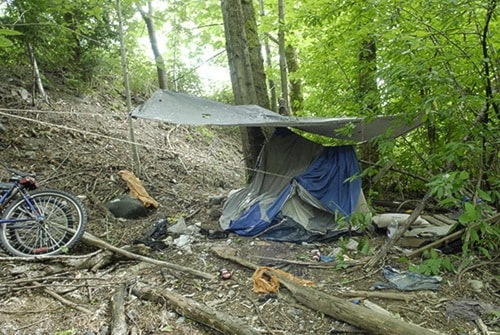While more than half of homeless people in Abbotsford acknowledge having addictions, only 6.2 per cent identify overcoming their addiction as the main barrier that would help end their homelessness, according to data in the 2014 Fraser Valley regional homeless count.
For homeless count research co-ordinator Ron van Wyk, this illustrates the complexity of helping the homeless, mentally ill or addicted, to get into housing.
“I think that just speaks to human nature. It’s one thing that maybe you admit that you have an issue, but it’s another thing to want to deal with it.”
The homeless count is a 24-hour snapshot survey run by volunteers to find out more about who is living on the streets and how they live.
Though the 2014 count found the number of homeless people has remained stable across the Fraser Valley region since 2011, Abbotsford saw the highest increase in those without a home. The local number rose from 117 to 151 between 2011 and 2014 – going up 29 per cent – while communities like Chilliwack saw a decrease. Mission’s number also rose from 54 to 75 – 39 per cent.
Abbotsford currently has a high-profile, politicized and highly visible homelessness issue – and finding solutions for individuals can be a complicated process.
The majority of homeless people surveyed said that affordable housing (42.2 per cent) or income (32 per cent) is the most significant barrier to becoming permanently housed.
When it comes to finding the funds, a large portion of the homeless are receiving a form of income assistance, including 36.3 per cent who are accessing welfare and 15.9 per cent who are on disability benefits.
Others rely on family and friends for money (9.7 per cent), panhandling (7.1 per cent), and binning or bottling (16.8 per cent.) Just under 12 per cent report no income.
The survey showed that many of the homeless have concurrent health issues, which, like all aspects of the survey, are self-identified. About 51.7 per cent say they have addictions, 27.8 per cent identify as having a mental illness, 19.9 per cent say they have a disability and 25.8 per cent report a medical condition of some kind.
Van Wyk said that while housing is necessary, the concurrent health problems illustrate the need for wrap-around services or a housing-first approach.
“This just illustrates the complexity of the situation. But we know that there are things that work.”
Van Wyk said that the health services that exist are good, but there just isn’t enough.
Men are still more highly represented among the homeless, with 60 per cent being male, 34 per cent female and six per cent unknown.
He added that there are always more men on the streets than women, because women, for reasons like safety, “tend to find alternatives arrangements and become less visible, especially if children are involved.”
On the day of the survey, 75 per cent of homeless people were not in any shelter, while 25 per cent were accessing emergency shelters or transitional housing.
In Abbotsford, youths and those between 30 and 50 years old, are disproportionately represented among the homeless.
While 15- to 19-year-olds make up seven per cent of the general population, 12 per cent of homeless youth are in that range. People between 30 to 39 years make up 12 per cent of the general population, but 27 per cent of the homeless fall within that range. Fourteen per cent of the general population is between 40 and 49, while it is about 28 per cent of the homeless population.
The survey showed that about 70 per cent of homeless people are coming from somewhere else other than the Fraser Valley Regional District, including 24 per cent from out of province, 20 per cent from around B.C. and 25 per cent from Metro Vancouver. But in Abbotsford, van Wyk said it is important to note that almost 40 per cent have lived in Abbotsford for more than 10 years.
In the time since the last survey in 2011, Abbotsford has built two large housing projects, the George Schmidt Centre and the Christine Lamb Centre. But Van Wyk said that if more facilities were built, they could easily be filled.
